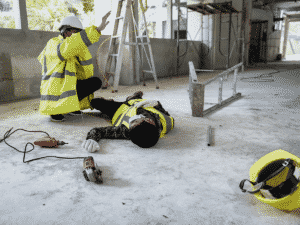How Long Injured Workers Have To File A Workers Comp Claim [2022]
How Long Injured Workers Have To File A Workers' Comp Claim
In this article we will discuss the time limits for filing a California Workers' Compensation Case and some common ways the time limit can be extended. The reader will also be introduced to the basic ideas of the statute of limitations, why it exists, why there are exceptions. This article is general information only and should not be relied upon by a layperson (or non-attorney) to determine when to file a case. Only an attorney can give you advise about such matters after hearing the particulars of your situation. If you need to speak to a work accident lawyer near Rancho Cucamonga, contact me at 909-962-8414 or visit workerscomplawyerie.com to submit an email and receive a call. This is how long injured workers have to file a workers' comp claim.
What Is A Statute of Limitations?
The Statute of Limitations (or SOL) is the time limit for bringing legal action in court. The statute of limitations is the law that sets the maximum time after an event within which legal proceedings may be initiated. The general rule is that once the statute of limitations “runs out” you can no longer file a lawsuit or other legal action seeking compensation for whatever happened.
The length of time that a legal claim has to be filed, or the period of time in which you must bring charges against someone who has harmed you, varies depending on the sort of lawsuit. For example, in California the general rule is that an action for negligence causing personal injury is 2 years. For workers' compensation claims, it's only 1 year from the date of injury.
Why Does the Workers' Comp Statute of Limitations Exist?
It is good public policy to end the rights of those who have been wronged for the sake of getting on with things. The SOL is therefore often called a statute of repose. Once the time limit has expired, unless legal action has already been filed in the appropriate court of law, the right to bring the claim is lost forever.
There are some good reasons for this rule. After a certain amount of time, witnesses die or move away, memories fade and evidence is lost. It would be unfair to the person who has been wronged to have to wait forever to get justice, but it would also be unfair to the person who may have harmed them to have to defend against a claim that is decades old.
The Statute of Limitations Can Be Extended In Certain Cases
There are of course exceptions that can extend or lengthen the period of time to commence a legal action. The exceptions exist because of a stronger or more important public policy interest that favors keeping the potential lawsuit alive. When an action is allowed to be brought after the normal SOL period, the SOL is said to have been “tolled.” Tolling can occur under a number of different circumstances depending on the type of claim sought to be preserved.
The most common example of tolling is for minors who are injured. A minor has until their 18th birthday plus two years to file a civil lawsuit. This tolling principle for workers' compensation claims in California. Keep reading to learn the nuances.
California Workers' Comp. Case Statute of Limitation Rules
The rules that govern the amount of time individuals have to bring a workers' compensation claim with the Workers' Compensation Appeals Board (or WCAB) appear simple, but they are filled with a slew of narrow exceptions. The basic SOL is one year from the date of the accident. The regulation is simple to apply in instances such as these, where there was a specific time and location for the injury to occur. However, for cumulative trauma injuries (those that occur as a result of repeated work activity over time), the rule is not always straightforward to apply.
As a general rule (with many exceptions not discussed here), the 1 year limitations period for a cumulative trauma starts to count on the last day of exposure to an occupational hazard that induced the health problem (the last day the employee was exposed to the occupational hazard).
Cumulative Trauma Limitations Period Nuances
As previously stated, the 1 or one year statute of repose is not without a number of exceptions some of which can be highly factual in nature. For example, if you continue to work without missing any work (no disability), then your cumulative trauma limitations period may not have started yet. Therefore, always consult a lawyer before assuming that an exception exists in your claim.
This is an important exception because many workers' compensation injuries are not immediately apparent. For example, if you hurt your back at work and go to the doctor a week later, the doctor may just give you some pain medication and tell you to take it easy for a few days. If your condition does not improve, you may go back to the doctor again. Then later, your doctor refers you to a specialist. The specialist may order an MRI, which shows that you have a herniated disc.
At this point, you finally realize that you have a workers' compensation claim. But because you did not know that you were injured, the 1-year statute of limitations would have already expired. The continuous trauma injury can extent the time period for filing a claim in these situations. This 2022 California Law allows you to extent the period if: 1) you missed no work; 2) you didn't know you had a work injury even if you missed work; 3) you were fired for reporting your injury.
Situations Where SOL Can Be Extended Beyond 1 Year
There are a number of exceptions that can extend the time limit past one year from the date of the incident. It is important to emphasize that whether these regulations extend the time limit for bringing a case in court may be determined on a case-by-case basis. Always consult Napolin Accident Injury Lawyer with questions. The following are some general guidelines that may extend the deadline:
- The insurance company pays for medical treatment and care of the injured employee. This adds 5 years to the time limit for bringing a lawsuit on to whatever date the is determined to start.
- The injured party is under the age of 18 on the day of the accident. When the individual reaches the age of majority, the one-year period will begin to count.
- The claimant is unable to submit a DWC-1 Claim Form to their employer, because they did not receive one upon reporting the accident, AND they were unaware of the workers compensation benefits procedure at their company.
- The afflicted employee is unaware that they have been harmed. This is the case with toxic exposure (asbestos instances are excluded from this discussion). In such circumstances, the one-year period begins on the date that the injury victim discovers it and that it is occupational in nature.
Every case is unique, and each individual should immediately contact an attorney to ensure that their legal rights are correctly protected. There may be other grounds for relief from the time limit under which you have one year.
Get Law Firm Help For Your Workers' Comp Case!
We help employees file workers' compensation claims at our firm serving the Inland Empire, Orange County, Los Angeles County, and Riverside County . If you believe you are ill as a result of your job, please contact us to talk with me the attorney about your case directly. Call me at 866-NAPOLIN and we will discuss the possibility of my professional services protecting your rights.
All consults are absolutely free of charge with no obligation to retain my firm. Furthermore, when we do take a case, no fees are due unless and until we obtain monetary recovery on your behalf. You pay us nothing out of pocket!
Se Habla Español.
- Understanding Uber Accidents and Insurance Coverage Periods in California - April 8, 2025
- A Guide on Red Light Auto Accidents in California - August 14, 2024
- Self-Representing in a California Personal Injury Claim - August 13, 2024



